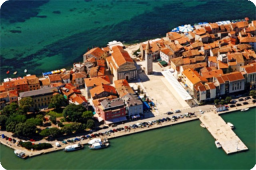

Umag/Istria
Umag/Istria  History of Umag
History of Umag
What is now a peninsula, used to be an island. The settlement itself was situated towards the back part of the port of Umag. The town walls, with the town gate and a drawbridge, were erected in the 10th century. They have been partially preserved in the south-western part, next to the Town Museum (which was one of the defence towers with battlements in the shape of a swallow's tale, which can still be seen from the sea).
At the entrance to the historic centre, stands the church of St. Roche, built after the plague epidemic in 1507. In the interior of the church, there is a remarkable wooden ceiling painted in oils, which dates back to the 18th century.
The parish church of the Assumption of the Virgin Mary and St. Peregrine, the patron saint of the city of Umag, was built according to the design of the architect Filippo Dongeti of Piran. The late baroque façade remained unfinished. On the interior side of the church entrance, there is a depiction of St. Peregrine in stone from the 14th century. The fresco on the church ceiling is attributed to Giuseppe Bernardino Bison of Palmanova. The main altar has statues of St. Peregrine and St. Nicefor.
In the church, there are various altarpieces and fragments of a wooden triptych from the 15th century. Attention should be paid to the statue of the Virgin Mary of Sorrows, attributed to followers of Vivarini. The church organ originates from 1776. The Venetian lion on the bell tower was originally found on the city hall, destroyed by fire in 1924. The 33-metre-high bell tower dates back to 1651.
The public cistern, dating back to 1677, was renovated in 1780. Behind the Parish Church, there is a metal ball, set in the wall, east of the apse. It is said to be a cannon ball fired by a ship from Genoa in 1810. Old houses with lovely windows, narrow streets, coats of arms and inscriptions are a recognisable part of Umag and can be found on the western side of the town.
At 3 Epifanio Street, there is an early Christian sarcophagus dating back to the 5th century which has been placed in the wall. On many houses, you will notice stone beams with holes in. These were used for hanging and displaying embroidered images on religious holidays. These also protected the interiors from the sun.
Finally, carry on to the breakwater. Its construction began in 1825 and it is 404 metres long.
On St. Peregrine beach, a church of the same name was erected in 1401 in the very place where, according to tradition, St. Peregrine was martyred.
Source: http://www.istra.hr/umag/
Video
Current news
 Macrocruise charter agency
Additional discount on the boat rental price of betw
Macrocruise charter agency
Additional discount on the boat rental price of betw





























